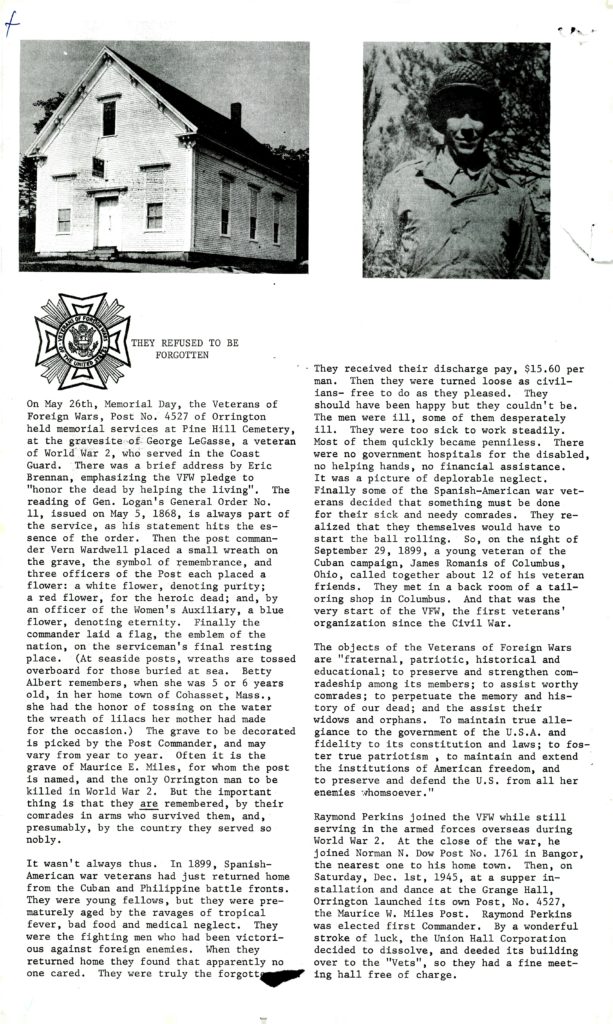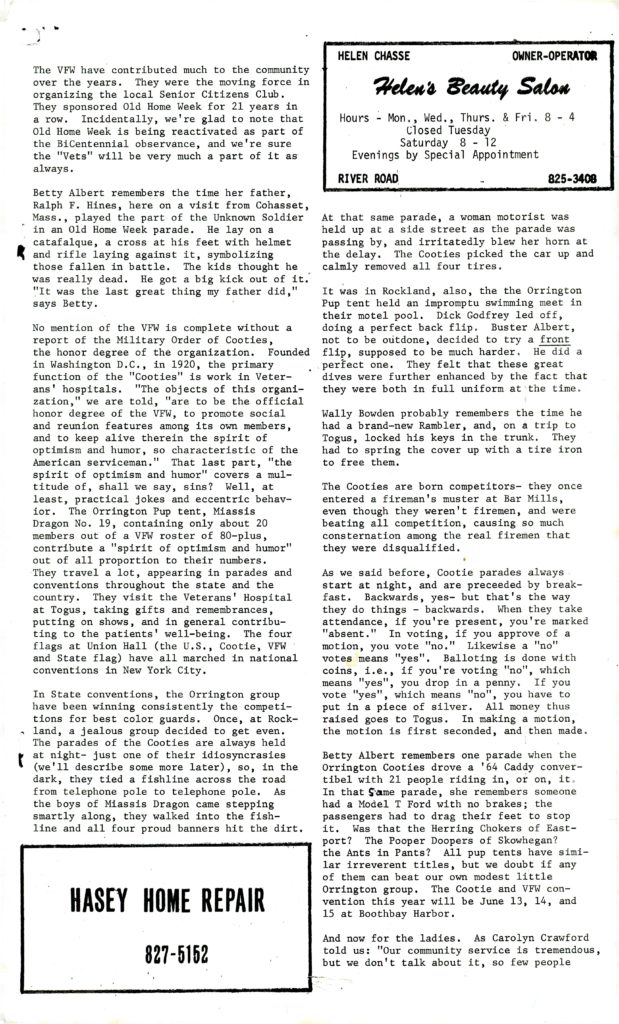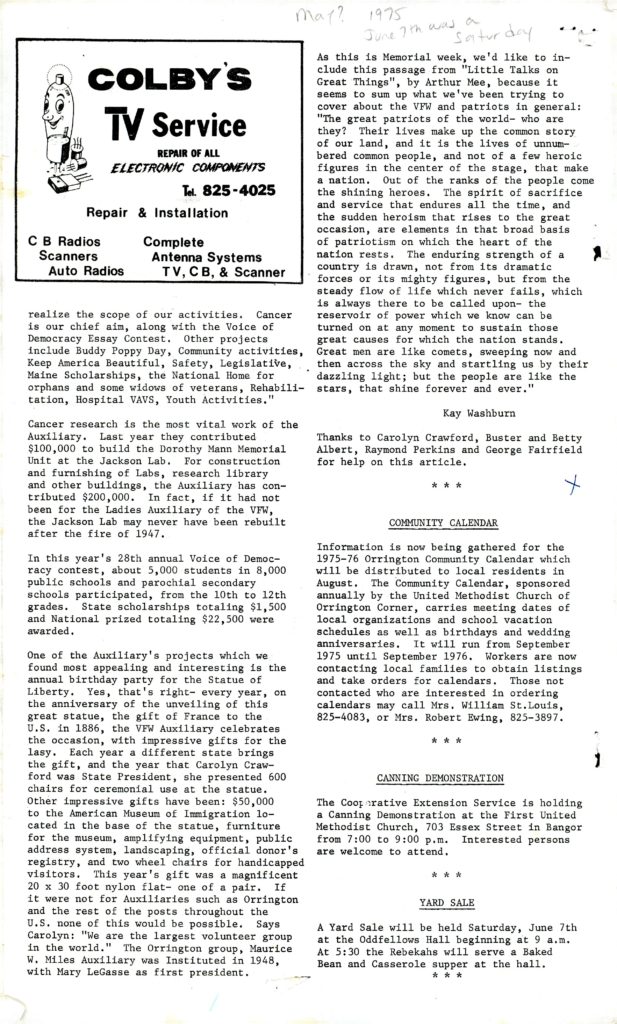by Kay Washburn
Thanks to Carolyn Crawford, Buster and Betty Albert, Raymond Perkins and George Fairfield for help on this article.
[Transcribed by P. Bickford-Duane, 11/6/17.]
On May 26th, Memorial Day, the Veterans of Foreign Wars, Post No. 4527 of Orrington, held memorial services at Pine Hill Cemetery, at the gravesite of George LeGasse, a veteran of World War 2, who served in the Coast Guard. There was a brief address by Eric Brennan, emphasizing the VFW pledge to “honor the dead by helping the living.” The reading of Gen. Logan’s General Order No. 11, issued on May 5, 1868, is always part of the service, as his statement hits the essence of the order. Then the post commander Vern Wardwell placed a small wreath on the grave, the symbol of remembrance, and three officers of the Post each placed a flower: a white flower, denoting purity; a red flower, for the heroic dead; and, by an officer of the Women’s Auxiliary, a blue flower, denoting eternity. Finally the commander laid a flag, the emblem of the nation, on the serviceman’s final resting place. (At seaside posts, wreaths are tossed overboard for those buried at sea. Betty Albert remembers, when she was 5 or 6 years old, in her home town of Cohasset, Mass., she had the honor of tossing on the water the wreath of lilacs her mother had made for the occassion.) The grave to be decorated is picked by the Post Commander, and may vary from year to year. Often it is the grave of Maurice E. Miles, for whom the post is named, and the only Orrington man to be killed in World War 2. But the important thing is that they are remembered, by their comrades in arms who survived them, and, persumably, by the country they served so nobly.
It wasn’t always thus. In 1899, Spanish-American war veterans had just returned home from the Cuban and Philippine battle fronts. They were young fellows, but they were prematurely aged by the ravages of tropical fever, bad food and medical neglect. They were the fighting men who had been victorious against foreign enemies. When they returned home they found that apparently no one cared. They were truly the forgotten. They received their discharge pay, $15.60 per man. Then they were turned loose as civilians – free to do as they pleased. They should have been happy but they couldn’t be. The men were ill, some of them desperately ill. They were too sick to work steadily. Most of them quickly became penniless. There were no government hospitals for the disabled, no helping hands, no financial assistance. It was a picture of deplorable neglect. Finally some of the Spanish-American war veterans decided that something must be done for their sick and needy comrades. They realized that they themselves would have to start the ball rolling. So, on the night of September 29, 1899, a young veteran of the Cuban campaign, James Romanis of Columbus, Ohio, called together about 12 of his veteran friends. They met in a back room of a tailoring shop in Columbus. And that was the very start of the VFW, the first veterans’ organization since the Civil War.
The objects of the Veterans of Foreign Wars are “fraternal, patriotic, historical and educational; to preserve and strengthen comradeship among its members; to assist worthy comrades; to perpetuate the memory and history of our dead; and to assist their widows and orphans. To maintain true allegiance to the government of the U.S.A. and fidelity to its constitution and laws; to foster true patriotism, to maintain and extend the institutions of American freedom, and to preserve and defend the U.S. from all her enemies whomsoever.”
Raymond Perkins joined the VFW while still serving in the armed forces overseas during World War 2. At the close of the war, he joined Norman N. Dow Post No. 1761 in Bangor, the nearest one to his home town. Then, on Saturday, Dec. 1st, 1945, at a supper installation and dance at the Grange Hall, Orrington launched its own Post, No. 4527, the Maurice W. Miles Post. Raymond Perkins was elected first Commander. By a wonderful stroke of luck, the Union Hall Corporation decided to dissolve, and deeded its building over to the “Vets,” so they had a fine meeting hall free of charge.
The VFW have contributed much to the community over the years. They were the moving force in organizing the local Senior Citizens Club. They sponsored Old Home Week for 21 years in a row. Incidentally, we’re glad to note that Old Home Week is being reactivated as part of the BiCentennial observance, and we’re sure the “Vets” will be very much a part of it as always.
Betty Albert remembers the time her father, Ralph F. Hines, here on a visit from Cohasset, Mass., played the part of the Unknown Soldier in an Old Home Week parade. He lay on a catalfaque, a cross at his feet with helmet and rifle laying against it, symbolizing those fallen in battle. The kids thought he was really dead. He got a big kick out of it. “It was the last great thing my father did,” says Betty.
No mention of the VFW is complete without a report of the Military Order of Cooties, the honor degree of the organization. Founded in Washington D.C., in 1920, the primary function of the “Cooties” is work in Veterans’ hospitals. “The objects of this organization,” we are told, “are to be the official honor degree of the VFW, to promote social and reunion features among its own members, and to keep alive therein the spirit of optimism and humor, so characteristic of the American serviceman.” That last part, “the spirit of optimism and humor” covers a multitude of, shall we say, sins? Well, at least, practical jokes and eccentric behavior. The Orrington Pup tent, Miassis Dragon No. 19, containing only about 20 members out of a VFW roster of 80-plus, contribute a “spirit of optimism and humor” out of all proportion to their numbers. They travel a lot, appearing in parades and conventions throughout the state and the country. They visit the Veterans’ Hospital at Togus, taking gifts and remembrances, putting on shows, and in general contributing to the patients’ well-being. The four flags at Union Hall (the U.S., Cootie, VFW and State flag) have all marched in national conventions in New York City.
In State conventions, the Orrington group have been winning consistently the competitions for best color guards. Once, at Rockland, a jealous group decided to get even. The parades of the Cooties are always held at night – just one of their idiosyncrasies (we’ll describe some more later), so, in the dark, they tied a fishline across the road from telephone pole to telephone pole. As the boys of Miassis Dragon came stepping smartly along, they walked into the fishline and all four proud banners hit the dirt.
At that same parade, a woman motorist was held up at a side street as the parade was passing by, and irritatedly blew her horn at the delay. The Cooties picked the car up and calmly removed all four tires.
It was in Rockland, also, that the Orrington Pup tent held an impromptu swimming meet in their hotel pool. Dick Godfrey led off, doing a perfect back flip. Buster Albert, not to be outdone, decided to try a front flip, supposed to be much harder. He did a perfect one. They felt that these great dives were furthered enhanced by the fact that they were both in full uniform at the time.
Wally Bowden probably remembers the time he had a brand-new Rambler, and, on a trip to Togus, locked his keys in the trunk. They had to spring the cover up with a tire iron to free them.
The Cooties are born competitors – they once entered a fireman’s muster at Bar Mills, even though they weren’t firemen, and were beating all competition, causing so much consternation among the real firemen that they were disqualified.
As we said before, Cootie parades always start at night, and are preceeded by breakfast. Backwards, yes – but that’s the way they do things – backwards. When they take attendance, if you’re present, you’re marked “absent.” In voting, if you approve of a motion, you vote “no.” Likewise a “no” vote means “yes.” Balloting is done with coins, i.e., you drop in a penny. If you vote “yes,” which means “no,” you have to put in a piece of silver. All money thus raised goes to Togus. In making a motion, the motion is first seconded, and then made.
Betty Albert remembers one parade when the Orrington Cooties drove a ‘64 Caddy convertible with 21 people riding in, or on, it. In that same parade, she remembers someone had a Model T Ford with no brakes; the passengers had to drag their feet to stop it. Was that the Herring Chokers of Eastport? The Pooper Doopers of Skowhegan? The Ants in Pants? All pup tents have similar irreverent titles, but we doubt if any of them can beat our modest little Orrington group. The Cootie and VFW convention this year will be June 13, 14, and 15 at Boothbay Harbor.
And now for the ladies. As Carolyn Crawford told us: “Our community service is tremendous, but we don’t talk about it, so few people realize the scope of our activities. Cancer is our chief aim, along with the Voice of Democracy Essay Contest. Other projects include Buddy Poppy Day, Community activities, Keep America Beautiful, Safety, Legislative, Maine Scholarships, the National Home for orphans and some widows of veterans, Rehabilitation, Hospital VAVS, Youth Activities.”
Cancer research is the most vital work of the Auxiliary. Last year they contributed $100,000 to build the Dorothy Mann Memorial Unit at the Jackson Lab. For construction and furnishing of Labs, research library and other buildings, the Auxiliary has contributed $200,000. In fact, if it had not been for the Ladies Auxiliary of the VFW, the Jackson Lab may never have been rebuilt after the fire of 1947.
In this year’s 28th annual Voice of Democracy contest, about 5,000 students in 8,000 public schools and parochial secondary schools participated, from the 10th to the 12th grades. State scholarships totaling $1,500 and National prizes totaling $22,500 were awarded.
One of the Auxiliary’s projects which we found most appealing and interesting is the annual birthday party for the Statue of Liberty. Yes, that’s right – every year, on the anniversary of the unveiling of this great statue, the gift of France to the U.S. in 1886, the VFW Auxiliary celebrates the occasion, with impressive gifts for the lasy. Each year a different state brings the gift, and the year that Carolyn Crawford was State President, she presented 600 chairs for ceremonial use at the statue. Other impressive gifts have been: $50,000 to the American Museum of Immigration located in the base of the statue, furniture for the museum, amplifying equipment, public address system, landscaping, official donor’s registry, and two wheel chairs for handicapped visitors. This year’s gift was a magnificent 20 x 30 foot nylon flat – one of a pair. If it were not for Auxiliaries such as Orrington and the rest of the posts throughout the U.S. none of this would be possible. Says Carolyn: “We are the largest volunteer group in the world.” The Orrington group, Maurice W. Miles Auxiliary was Instituted in 1948, with Mary LeGasse as first president.
As this is Memorial week, we’d like to include this passage from “Little Talks on Great Things,” by Arthur Mee, because it seems to sum up what we’ve been trying to cover about the VFW and the patriots in general: “The great patriots of the world – who are they? Their lives make up the common story of our land, and it is the lives of unnumbered common people, and not of a few heroic figures in the center of the stage, that make a nation. Out of the ranks of the people come the shining heroes. The spirit of sacrifice and service that endures all the time, and the sudden heroism that rises to the great occasion, are elements in that broad basis of patriotism on which the heart of the nation rests. The enduring strength of a country is drawn, not from its dramatic forces or its mighty figures, but from the steady flow of life which never fails, which is always there to be called upon – the reservoir of power which we know can be turned on at any moment to sustain those great causes for which the nation stands. Great men are like comets, sweeping now and then across the sky and startling us by their dazzling light; but the people are like the stars, that shine forever and ever.”



